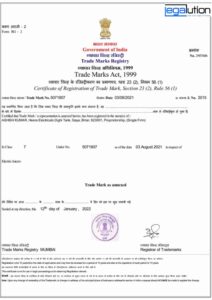
Trademark Registration in India – Quick Process
In This blog post will explain everything about Trademark Registration in India. If you follow the steps below, you can easily Register your Trademark in India.
Table of Contents
ToggleWhat is Trademark ?
A trademark is a legally protected symbol, word, phrase, logo, or design that represents a brand or product, distinguishing it from others in the marketplace.
Trademarks are used to identify and protect the unique identity and source of goods or services, helping consumers recognize and trust a specific brand.
What are the Benefits of Registering a Trademark for Your Business?
In the competitive landscape of today’s business world, protecting your brand identity is essential for long-term success. One effective way to safeguard your business’s unique assets is by registering a trademark.
A trademark is a symbol, logo, word, or phrase that distinguishes your goods or services from others in the marketplace. Read on and know about the numerous benefits of registering trademark for your business, emphasizing the advantages of online registration.
- Legal Protection and Exclusive Rights
Registering a trademark provides legal protection and grants you exclusive rights to use that mark in connection with your products or services. It establishes your ownership and helps prevent others from using similar marks that could cause consumer confusion.
In the event of infringement, registered trademarks offer stronger legal recourse, allowing you to take legal action against unauthorized use or imitation. By securing your trademark, you safeguard your business’s reputation and ensure that customers can easily identify and trust your brand.
- Brand Recognition and Customer Loyalty
A registered trademark is a valuable asset that contributes to your brand recognition and fosters customer loyalty. When customers see your registered trademark consistently associated with high-quality products or services, it builds trust and credibility.
A recognizable and protected trademark can differentiate your business from competitors, enhancing your brand’s visibility and establishing a lasting impression in the minds of consumers.
By investing in a registered trademark, you create a foundation for building brand loyalty and a strong customer base.
- Market Advantage and Expansion Opportunities
A registered trademark gives your business a competitive edge in the marketplace. It prevents others from using similar marks, reducing the risk of brand dilution or confusion.
Registering a trademark also provides a foundation for future growth and expansion. Expansion opportunities are one of the major reasons to register your trademark online today and set your business on the path to success.
With a protected mark, you can confidently enter new markets, introduce new products, or extend your services, knowing that your brand identity is secured.
It enables you to create licensing or franchising opportunities, further strengthening your market position and opening doors to collaborations and partnerships.
- Asset Value and Business Opportunities
A registered trademark adds value to your business as an intangible asset. It can appreciate over time and contribute to the overall worth of your company, making it an attractive prospect for potential investors or buyers.
Registered trademarks often serve as collateral for loans, offering financial opportunities to support business growth. Moreover, a trademark registration demonstrates your commitment to protecting intellectual property rights, which can be a significant advantage when seeking funding, partnerships, or business collaborations.
What is the term of trademark registration in India
In India, the term of trademark registration is initially for ten years from the date of filing the application. After the initial ten-year period, the trademark registration can be renewed indefinitely for successive periods of ten years each.
To maintain the validity of the trademark registration, the owner must file a renewal application with the appropriate fee within the prescribed period. It’s essential to keep track of the renewal deadlines to ensure that the trademark rights remain in force.
The renewal process typically involves submitting the renewal application, paying the renewal fees, and providing any necessary documentation as required by the trademark office. Failure to renew the registration within the specified time frame may result in the removal of the trademark from the register, and the owner may lose the exclusive rights associated with the mark.
What are the types of trademark?
Trademarks can take various forms based on the distinctive features and elements they represent. Here are some common types of trademarks:
Word Mark: A trademark that consists of one or more words, letters, or numbers. Examples include brand names like Apple, Microsoft, or Coca-Cola.
Design Mark: Also known as a logo or stylized mark, this type of trademark includes a unique design, symbol, or graphical representation. Famous examples include the Nike swoosh or the Starbucks mermaid logo.
Combination Mark: This type combines both words and a graphical element. The text and the design may be used together to create a distinctive brand identity. Examples include the Burger King logo with both text and an image of a burger.
Slogan/Tagline: Some trademarks are based on memorable phrases or slogans associated with a particular brand, like Nike’s “Just Do It” or McDonald’s “I’m Lovin’ It.”
Color Mark: Trademarks can also be associated with specific colors. For example, the distinct brown color of the UPS delivery trucks is a registered trademark.
Sound Mark: This type of trademark is associated with a particular sound or jingle. Examples include the NBC chimes or the Intel jingle.
Motion Mark: Trademarks can also involve moving images or animations. These are often used in advertising and entertainment industries.
Three-Dimensional (3D) Mark: This type of trademark involves the shape or configuration of a product or its packaging. For instance, the unique shape of the Coca-Cola bottle.
Certification Mark: This mark is used to indicate that goods or services meet certain standards or specifications. An example is the “Fair Trade” certification mark.
Collective Mark: Similar to a certification mark, a collective mark is used by members of an organization to identify their goods or services. It is a symbol of a collective effort.
Trade Dress: This refers to the overall appearance and image of a product or its packaging, which can be protected as a trademark if it is distinctive and serves as an identifier of the source.
Who can Apply for Trademark Registration?
The following individuals and entities are eligible to apply for trademark registration in India:
Individuals: Any person, including entrepreneurs and sole proprietors, can apply for trademark registration to protect their personal or business brand.
Businesses and Companies: Various types of business entities, such as companies, partnerships, limited liability partnerships (LLPs), and proprietorships, can apply for trademark registration to safeguard their brand names, logos, or other distinctive marks associated with their goods or services.
Startups: Startups and emerging businesses in India are encouraged to apply for trademark registration to establish and protect their brand identity from the early stages of their operations.
Proprietorship Firms: Sole proprietorships, where an individual operates a business as the sole owner, can apply for trademark registration to protect their business name or logo.
Government Entities: Government departments and organizations can apply for trademark registration to protect official logos, emblems, and other marks associated with their activities.
Foreign Entities: Individuals and businesses located outside India can also apply for trademark registration in the country. However, they may need to appoint an authorized representative in India for the application process.
Nonprofit Organizations: Nonprofit organizations, charitable trusts, and societies engaged in activities that involve the use of a brand name, logo, or slogan can apply for trademark registration to protect their identity.
Choosing the Correct Trademark Class
Trademark classes, which divide products and services into 45 different classes, are an essential part of the registration procedure.
It is crucial to carefully choose the right class for your trademark registration since it affects the goods and services that your company offers.
It is imperative that you file for a trademark under each applicable class if your business works in many sectors that fall under distinct classifications.
In India, the following trademark classes are commonly selected:
Class 9: Covering electronics and computer software
Class 25: Clothes with sleeves
Class 35: Advertising and business management
Class 41: Information and entertainment-related
Required Documents & Details for Online Trademark Registration
In order to start the online trademark registration procedure in India, the following essential details must be provided:
Name of Applicant: The name of the person, business, or organization submitting an application to register a trademark.
Business Type: Indicate the kind of business organization, such as a private limited company, partnership, or sole proprietorship.
Business Objectives: Give a succinct overview of your company’s goals and operations.
Name of Brand/Logo/Slogan: Make sure to specify the name, logo, or slogan you plan to trademark.
Registration Address: Provide the official address of the organization submitting the trademark application.
Procedure for Trademark Registration in India
Now we discuss about procedure for trademark registration in India . Registering a trademark in India involves several steps. Here is a simplified guide on how to register a trademark in India:
- Trademark Search: Before applying for a trademark, conduct a comprehensive search to ensure that your desired trademark is unique and not already registered by someone else.
- Choose the Right Class: Determine the appropriate class or classes under which your goods or services fall. Trademarks are categorized into different classes, and you must specify the class(es) relevant to your business.
- Create a Unique Trademark: Develop a distinctive and unique trademark that represents your brand. It can be a word, logo, symbol, slogan, or a combination thereof.
- Trademark Application: File a trademark application with the Indian Trademark Registry. You can do this online through the official website.
- Examination and Publication: After submitting your application, it will be examined by the Trademark Office. If there are no objections, your trademark will be published in the Trademark Journal for public scrutiny. If there are any objections, you will be notified, and you can respond to them within the stipulated time frame.
- Opposition Period: Your trademark will be open for opposition by third parties for a specified period (usually four months) from the date of publication. If there are no oppositions or if you successfully overcome any objections, your trademark will proceed to registration.
- Registration and Certificate: Once your trademark application is accepted and there are no oppositions, the Registrar will issue a Certificate of Registration
- Trademark Renewal: Trademarks are initially registered for ten years. You can renew your trademark registration indefinitely every ten years by filing a renewal application and paying the required fee.
- Enforce Your Trademark: After registration, it’s essential to actively protect and enforce your trademark rights to prevent others from using it without your permission.
Trademark Registration in India Fees
Trademark registration fees in India can vary depending on various factors, including the type of applicant (individual, startup, small enterprise, etc.), the number of classes, and whether you file online or offline.
Cost of Trademark Registration in India
Online Filing for Individual/Startup/Small Enterprise:
- For one class: Approximately INR 4,500 to INR 5,000
- For each additional class: Approximately INR 4,500 to INR 5,000
Online Filing for Others (Companies, etc.):
- For one class: Approximately INR 9,000 to INR 10,000
- For each additional class: Approximately INR 9,000 to INR 10,000
Get Trademark Registration at Lowest price
Contact UsWhat is Trademark Renewal
Trademark renewal is a crucial process that helps maintain the validity of your trademark registration. In many jurisdictions, including India, trademarks are typically initially registered for a period of ten years. To ensure continued protection, you need to renew your trademark registration periodically. Below is a general guide to the trademark renewal process:
Detailed Guide –Trademark Renewal Process In India
Trademark Renewal Process
-
Check Renewal Deadline:
- Be aware of the renewal deadline, which is usually around the tenth anniversary of the registration date. Renewals can typically be filed within six months before the expiration date.
-
Prepare Renewal Application:
- Obtain the official renewal application form from the intellectual property office’s website or filing system. In some jurisdictions, renewal can be done online.
-
Provide Necessary Information:
- Complete the renewal application with accurate and up-to-date information. You may need to provide details about the trademark, the owner, and the classes of goods or services.
-
Payment of Renewal Fees:
- Pay the required renewal fees. The fee amount may depend on factors such as the number of classes covered by the trademark.
-
Submit Renewal Application:
- Submit the renewal application and payment through the designated online portal or by following the specified submission process.
-
Receive Renewal Certificate:
- Once the renewal application is processed and approved, the intellectual property office will issue a renewal certificate. This certificate serves as evidence that your trademark registration has been extended for another period (often ten years).
-
Monitor for Communication:
- Keep an eye on any communication from the intellectual property office. In some cases, they may request additional information or clarification.
Important Considerations
Timely Renewal:
- Ensure that you submit the renewal application and fees well before the expiration date to avoid any lapse in protection.
Late Renewal:
- Some jurisdictions may allow for a late renewal within a grace period after the expiration date, but additional fees may be incurred.
Continuous Monitoring:
- Regularly monitor the renewal deadlines for your trademarks to prevent inadvertent lapses in protection.
Update Contact Information:
- Keep your contact information updated with the intellectual property office to receive timely notifications.
Consult with Professionals
Trademark renewal procedures can vary by jurisdiction, so it’s essential to refer to the specific guidelines provided by the intellectual property office in your country. Consulting with a trademark attorney or agent can be beneficial to ensure that the renewal process is completed accurately and in compliance with local regulations.
How to Handle a Trademark Objection
A trademark objection occurs when the trademark examiner at the intellectual property office raises concerns or issues with your trademark application during the examination process. This can happen for various reasons, and it’s essential to address the objections promptly to move the application forward. Here’s a guide on how to handle a trademark objection:
1. Receipt of Examination Report:
- After filing your trademark application, the intellectual property office will conduct an examination. If there are concerns, you will receive an examination report outlining the objections.
2. Review the Examination Report:
- Carefully review the examination report to understand the specific objections raised by the trademark examiner. Common objections may include issues related to distinctiveness, similarity with existing marks, or improper classification of goods/services.
3. Understand the Objections:
- Identify the nature of the objections and understand the reasons behind them. This understanding is crucial for preparing an effective response.
4. Consult with a Trademark Professional:
- Consider seeking guidance from a trademark attorney or agent. They can provide valuable insights, help formulate a strong response, and navigate the objection resolution process.
5. Prepare a Response:
- Address each objection raised by the examiner in a clear and concise manner. Provide evidence and arguments supporting the registrability of your trademark.
6. Submit a Formal Response:
- Prepare and submit a formal response to the intellectual property office within the specified time frame. Failure to respond within the deadline may result in the abandonment of your application.
7. Amendments and Clarifications:
- If necessary, consider making amendments to the application or providing additional clarifications to overcome the objections. This could involve modifying the description of goods/services or presenting evidence of acquired distinctiveness.
8. Negotiation or Hearing (if applicable):
- In some cases, a negotiation or a hearing may be required to resolve objections. This process may involve discussions with the trademark examiner to address concerns or arguments raised during the objection stage.
9. Follow-up:
- Regularly check the status of your application to ensure that any additional information or actions requested by the intellectual property office are promptly provided.
10. Decision:
- The trademark office will review your response, and if they are satisfied, they will proceed with the registration process. If the objections are not adequately addressed, your application may be refused.
Additional Considerations
Keep Records:
- Maintain records of all communications, including the examination report, your response, and any supporting documents.
Timely Action:
- Act promptly to address objections within the specified time frame to avoid potential abandonment of your application.
Professional Assistance:
- Given the legal nuances involved, seeking professional assistance can significantly enhance your chances of successfully overcoming objections
Conclusion
Registering a trademark for your business offers a wide range of benefits, from legal protection and exclusive rights to brand recognition and market advantages.
Online Trademark registration has made the process more convenient and accessible, allowing businesses to efficiently protect their intellectual property rights. To experience these advantages, it is crucial to consult with legal professionals or trademark experts who can guide you through the registration process and ensure compliance with relevant laws and regulations.
Trademark Registration FAQ's
Registering your trademark provides legal protection, exclusive rights, brand recognition, and the ability to take legal action against infringement, ultimately safeguarding your brand and its value.
Trademark registration is available to a broad range of entities, including individuals, companies, proprietorship firms, partnerships, LLPs, both Indian and foreign companies, as well as trusts and societies.
Starting At: Rs.1,499 + Govt. Fees
In India, there is a diverse range of trademark registrations available, encompassing product marks, service marks, collective marks, certification marks, shape marks, pattern marks, and sound marks




